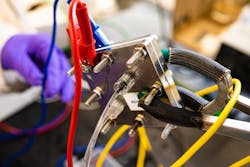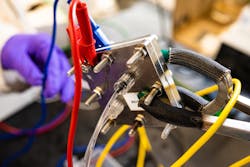Lab Advances Water-Splitting Catalysts for Clean Hydrogen
A team of researchers at Rice University, the University of Pittsburgh and the University of Virginia have discovered a method that could make water electrolysis used to produce clean hydrogen fuels more economical and practical.
The researchers replaced rare and expensive iridium with ruthenium, a far more abundant precious metal, as the positive-electrode catalyst in a reactor that splits water into hydrogen and oxygen. Adding nickel to ruthenium dioxide (RuO2) resulted in a robust anode catalyst that produced hydrogen from water electrolysis for thousands of hours under ambient conditions.
According to Haotian Wang at Rice’s George R. Brown School of Engineering, iridium costs roughly eight times more than ruthenium, and it could account for 20% to 40% of the expense in commercial device manufacturing, especially in future large-scale deployments.
“There’s huge industry interest in clean hydrogen,” says Wang. “It’s an important energy carrier and also important for chemical fabrication, but its current production contributes a significant portion of carbon emissions in the chemical manufacturing sector globally. We want to produce it in a more sustainable way, and water-splitting using clean electricity is widely recognized as the most promising option.” (Note, for more on this topic, see “Is Hydrogen the New Wonder Fuel?”)
In their study, detailed in a recent article in Nature Materials, Wang’s team demonstrated that ultrasmall and highly crystalline RuO2 nanoparticles with nickel dopants, used at the anode, facilitated water-splitting for more than 1,000 hours at a current density of 200 milliamps per square centimeter with negligible degradation.
They tested their anodes against others of pure ruthenium dioxide that catalyzed water electrolysis for a few hundred hours before beginning to decay.
“Now that we’ve reached this stability milestone, our challenge is to increase the current density by at least five to 10 times while still maintaining this kind of stability,” Wang says. “This is very challenging, but still possible.”
“Increase of the current density will decrease the stability of OER catalysts. We will further develop better Ru-based OER catalysts, and meanwhile optimize anode preparation methods,” he adds.
The team also plans to carry out studies on temperature effects, multi-element doping, and more. “The first factor we would like to target is multi-element doping, because this study has demonstrated the dopants can effectively enhance the stability of RuO2. Doping RuO2 catalyst with multi-element could be a good method to develop highly stable acidic OER catalysts. This experiment is ongoing in my lab,” says Wang.
“The annual production of iridium won’t help us to produce the amount of hydrogen we need today,” Wang shares. “Even using all the iridium globally produced will simply not generate the amount of hydrogen we will need if we want it to be produced via water electrolysis.
“That means we can’t fully rely on iridium,” he adds. “We have to develop new catalysts to either reduce its use or eliminate it from the process entirely.”
About the Author
Chemical Processing Staff
Chemical Processing's editors cover industry news relevant to readers. You can email your news items to Editor-in-Chief Traci Purdum at [email protected].

